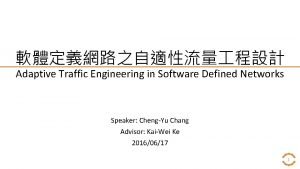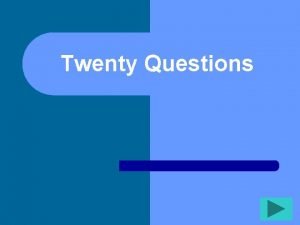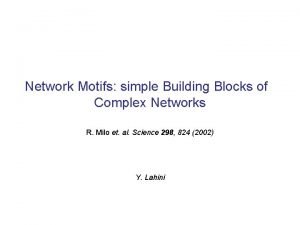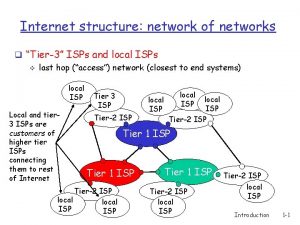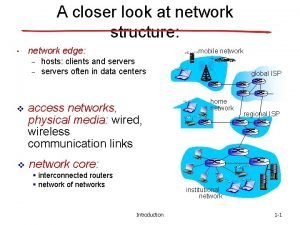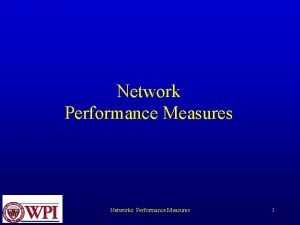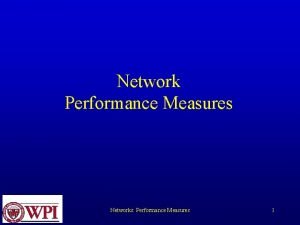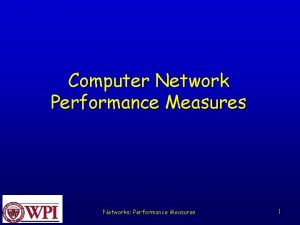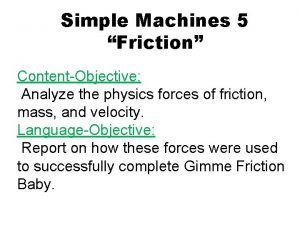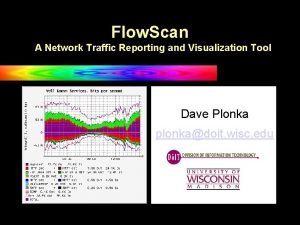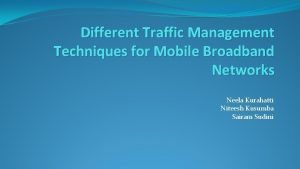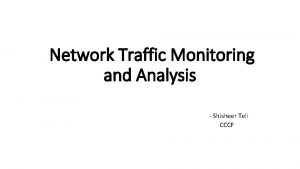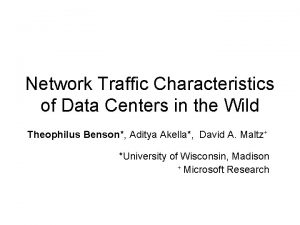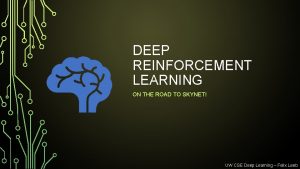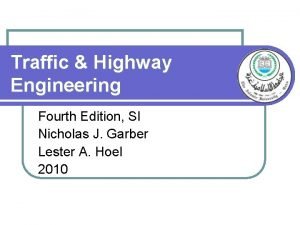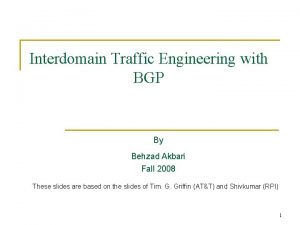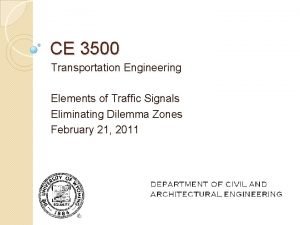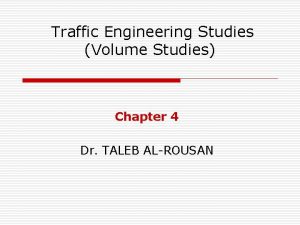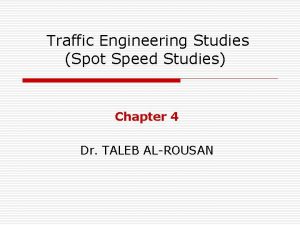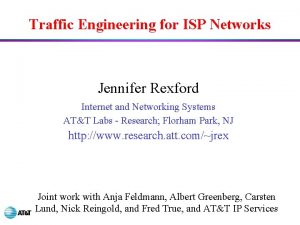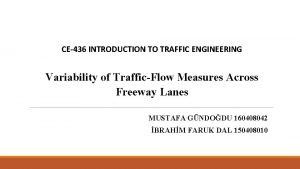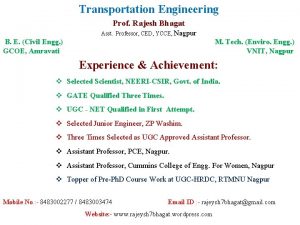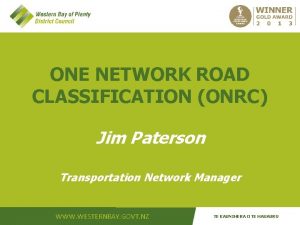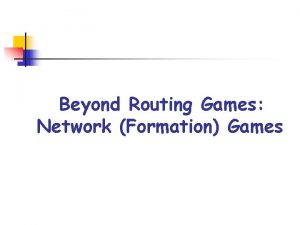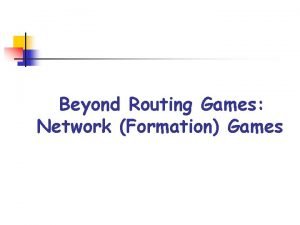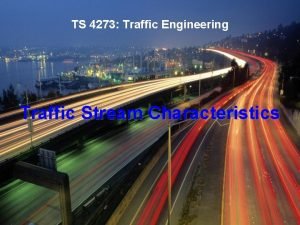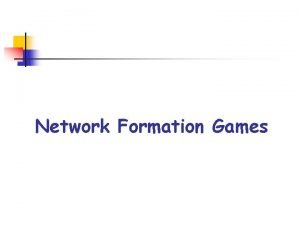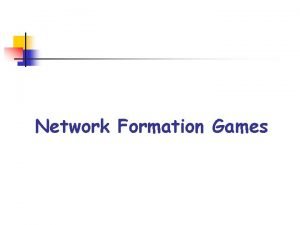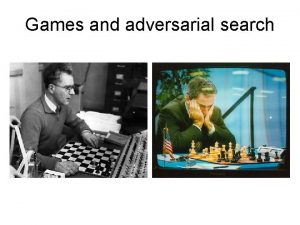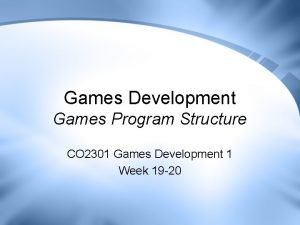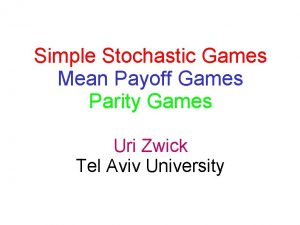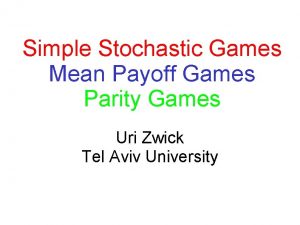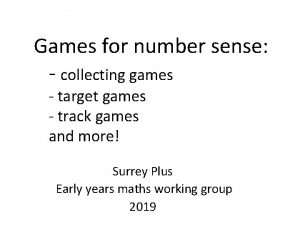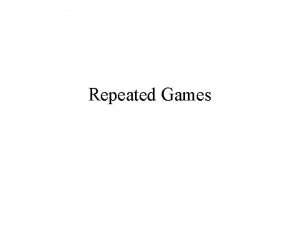NETWORK ENGINEERING GAMES ROAD TRAFFIC NETWORKS Road traffic



![TELECOM NETWORKS: §Flow control games appear in 1989 with the dissertation of Douligeris [Do-1989]. TELECOM NETWORKS: §Flow control games appear in 1989 with the dissertation of Douligeris [Do-1989].](https://slidetodoc.com/presentation_image_h2/403d3224071d53674cb31b8394d2e66d/image-4.jpg)
![TELECOM NETWORKS: [MMD-1991] R. Mazumdar , L. Mason L and C. Douligeris. “Fairness in TELECOM NETWORKS: [MMD-1991] R. Mazumdar , L. Mason L and C. Douligeris. “Fairness in](https://slidetodoc.com/presentation_image_h2/403d3224071d53674cb31b8394d2e66d/image-5.jpg)



![ENERGY VS TELCOM NETWORKS Models used in the grid for controlling congestion [LW-2017], [PG ENERGY VS TELCOM NETWORKS Models used in the grid for controlling congestion [LW-2017], [PG](https://slidetodoc.com/presentation_image_h2/403d3224071d53674cb31b8394d2e66d/image-9.jpg)






![MODELLING THE IMPACT OF CONGESTION ON THE ENVIRONMENT [MK-2011] M Madireddya, B De Coense MODELLING THE IMPACT OF CONGESTION ON THE ENVIRONMENT [MK-2011] M Madireddya, B De Coense](https://slidetodoc.com/presentation_image_h2/403d3224071d53674cb31b8394d2e66d/image-16.jpg)





![LOAD BALANCING IN [ORS] FRAMEWORK If AB incurs no delay then we have a LOAD BALANCING IN [ORS] FRAMEWORK If AB incurs no delay then we have a](https://slidetodoc.com/presentation_image_h2/403d3224071d53674cb31b8394d2e66d/image-22.jpg)























- Slides: 45

NETWORK ENGINEERING GAMES

ROAD TRAFFIC NETWORKS Road traffic community introduces the traffic assignment problem: - routing game of choosing paths so that at equilibria each player uses a minimum cost path. Wardrop models these as a continuum of players. Population games. [BMW-1956] Beckmann et al identify a potential that will be obtained by Rosenthal in a discrete setting in the 70 ies. Beckman introduced continuum of paths Had received attention of economists even earlier, e: g: Pigou. _____________________________ JG Wardrop, “Some theoretical aspects of road traffic research, Proc. Inst. Civ. Eng. 2: 325 -378, 1952. M. Beckmann et al, Studies in the Economics of Transportation. Yale Univ. Press, 1956.

SCIENTIFIC CONTEXT Later the problem is studied in telecom networks with tools from - optics in random environment, -- Electrostatics -- Electrodynamics -- tranport -- Potentil games
![TELECOM NETWORKS Flow control games appear in 1989 with the dissertation of Douligeris Do1989 TELECOM NETWORKS: §Flow control games appear in 1989 with the dissertation of Douligeris [Do-1989].](https://slidetodoc.com/presentation_image_h2/403d3224071d53674cb31b8394d2e66d/image-4.jpg)
TELECOM NETWORKS: §Flow control games appear in 1989 with the dissertation of Douligeris [Do-1989]. They were further studied by R. Mazumdar and by A A Lazar and their coauthors [MMD-1991, HL-1991]. §Modeled as stochastic games with constraints. (eg min delay subject to throughput constraints) §Routing games were brought into the community of Telecommunication Networks by Orda et al [ORS-1993] on 1993. §Can be viewed as a population game with finitely many players (but with an infinite population)
![TELECOM NETWORKS MMD1991 R Mazumdar L Mason L and C Douligeris Fairness in TELECOM NETWORKS: [MMD-1991] R. Mazumdar , L. Mason L and C. Douligeris. “Fairness in](https://slidetodoc.com/presentation_image_h2/403d3224071d53674cb31b8394d2e66d/image-5.jpg)
TELECOM NETWORKS: [MMD-1991] R. Mazumdar , L. Mason L and C. Douligeris. “Fairness in network optimal flow control: optimality of product forms”. IEEE Transactions on Communications 1991 [HL-1991] M. T. Hsiao and A. A. Lazar, “Optimal decentralized flow control of Markovian queueing networks with multiple controllers”. Performance Evaluation 13: 181– 204, 1991. [ORS-1993] A. Orda, R. Rom, and N. Shimkin, “Competitive routing in multi-user communication networks, ” IEEE/ACM Transactions on Networking, 1(5), 510– 520, 1993 The framework of ORS and its relation to Wardrop was studied by Harie and Marcott

THE ISO MODEL The Open Systems Interconnection (OSI) reference model was developed by the International Standards Organisation (ISO) as a model for computer communications architectures, and as a framework for developing protocol standards. It was intended as a first step towards international standardisation of communications protocols

EX. OF COMPETITION IN TELECOMMUNICATIONS 1. Physical layer: competition over the quality of the signal through the choice of transmission power in wireless communications 2. Link layer: when to retransmit a packet that corrupted due to collision or to noise 3. Networking layer: which path to choose for routing traffic from a source to a destination 4. Transport layer: which version of the TCP-IP protocol to use. 5. Application layer : e. g. content competing for influence,

POWER NETWORKS A power grid system is divided into two main phases: electric power transmission (high voltage) and electric power distribution. The first phase deals with the transfer of energy, over transmission lines, to substations that service some geographical areas. In contrast, power distribution is the last stage for delivering electricity in which the distribution network carries the electricity received at a substation and, subsequently, delivers it to the consumers. There has been a growing interest in controlling the loads and sources of energy such as solar panels or wind turbines at the distribution networks which can provide energy to small
![ENERGY VS TELCOM NETWORKS Models used in the grid for controlling congestion LW2017 PG ENERGY VS TELCOM NETWORKS Models used in the grid for controlling congestion [LW-2017], [PG](https://slidetodoc.com/presentation_image_h2/403d3224071d53674cb31b8394d2e66d/image-9.jpg)
ENERGY VS TELCOM NETWORKS Models used in the grid for controlling congestion [LW-2017], [PG 2018] are similar to the routing games in [ORS-1993]. Individuals can both consume, store or send energy that they produce. The game has a basic property common to both road traffic congestion game models as well as to routing games: the link cost of a user depends on the flows of other players through that link only through their sum. Games with this structure are called aggregative games [LW-2017]. ____________________________ ___ [LW-2017] Z. Liu, Q. Wu, S. Huang, L. Wang, M. Shahidehpour and Y. Xue, "Optimal Day-ahead Charging Scheduling of Electric Vehicles through an Aggregative Game Model, " IEEE Transactions on Smart Grid [PG-2018] D Paccagnan, B Gentile, F Parise, M Kamgarpour and J

COST CRITERIA Delay costs in road traffic are often polynomial, see BPR. Monotone cost, uniquue EQ In Telecom games, protocols are analyzed using queueing theory. In many models, queueing delays at a link holding cost are modeled as 1/(C-x). C is the link capacity and x is the total link flow If x > C then all users sending positive flow through a link have infinite cost. Thus the capacity constraints are enforced by the users cost. Yet the cost grows to infinity continuously. In grid netorks, enforcing a capacity limit is desired, even if the cost is still finite. We can model this as a cost that goes to infinity when exceeding a limit on the flow through a link. But then the cost is not continuous. To solve the game one formulates it as a game with coupled constraints [Rosen] __________________________________

NON-ADDITIVE LINK COSTS

NON CONSERVATION OF FLOWS In road traffic there is flow conservation: the flow into a node equals that leaving a node. In telecom we may loose conservation of flows as 1. packets may be lost due to noise, interferrence, collisions. 2. Sessions may be blocked due to lack of resources 3. In multicast sessions, packets are duplicated so that each destination of a group receive a copy. Thus less enter nodes than those leaving the nodes.

COUPLING BETWEEN LAYERS AND PERF MEASURES Performance of different layers are coupled. Ex 1: TCP uses loss of packets as a signal of congestion and reacts in decreasing the throughput. It retransmits losses. Thus losses are transformed into larger delays, lower throughput Ex 2: When video or voice are played, the seauence of events at destination should be the same as at the. Thus if a packet does not arrive in time to be played then it is useless and it is dropped. Here delay creates losses

HOW BAD IS ROAD TRAFFIC Road. CONGESTION traffic congestion damage: "In the U. S. alone, congestion cost $305 billion last year [2017], an increase of $10 billion from 2016…” see https: //www. citylab. com/transportation/2018/02/traffics-mind-boggling-economic -toll/552488/ Externality on environment: “passenger vehicles are a highly visible source of greenhouse gases that has the potential to continue growing steadily through 2030 and beyond. “Wheel-to-wheel carbon emissions from these vehicles accounted for about 7 percent of global greenhouse gas emissions in 2006. Unabated annual carbon emissions from passenger vehicles are, however projected to climb more than 54 percent by 2030, reaching 4. 7 Giga-tons (Gt) CO 2 that year. ”

MODELLING THE IMPACT OF CONGESTION ON THE ENVIRONMENT Modelling emission as a function of road traffic congestion is quite difficult [GW-2016]. Many papers restrict the study of this problem to one given town and the results reported are usually in the form of measurements or simulation studies or combination between simulations and physical models obtained through measurements of the emission [SB-2009, MC-2011, SB-2009]. There are many factors that contribute to the emission: acceleration behavior, the type of petrol or of energy used etc. , the type of the car, see the Versit+ model [SSR-2007] that studies the impact of different parameters on the emission in Antwerp. A very simple model that relates congestion to emission is the link emission factor [Na-2000]. While it may seem simplistic, it allows to identify important paradoxical behavior in which increasing congestion
![MODELLING THE IMPACT OF CONGESTION ON THE ENVIRONMENT MK2011 M Madireddya B De Coense MODELLING THE IMPACT OF CONGESTION ON THE ENVIRONMENT [MK-2011] M Madireddya, B De Coense](https://slidetodoc.com/presentation_image_h2/403d3224071d53674cb31b8394d2e66d/image-16.jpg)
MODELLING THE IMPACT OF CONGESTION ON THE ENVIRONMENT [MK-2011] M Madireddya, B De Coense et al, « Assessment of the impact of speed limit reduction and tra�c signal coordination on vehicle emissions using an integrated approach”, Transportation Research Part D: Transport and Environment, 16(7)504 -508, 2011 [GW-2016] M Grote, I Williams, J Preston, S Kemp, "Including congestion effects in urban road traffic CO 2 emissions modelling: Do Local Government Authorities have the right options? ", Transportation Research Part D: Transport and Environment, Vol 43, 2016, 95 -106. [Na-2000] Anna Nagurney, Congested urban transportation networks and emission paradoxes, Transportation Research Part D: Transport and Environment, 5(2), 145 -151, 2000

EXTERNALITIES OF CONGESTION Congestion in computer networks. In the entry “Network congestion” in Wikipedia it is written that “If we want to create a sustainable future for the internet, we need a new way of solving the congestion problem. Today, the solution is simply to add more capacity. “ Network congestion may occur at different levels: at the access to the network, where phenomena as collisions and interference may play an important role, at flow control at the link level as well as at the end-to-end level. Network congestion and environment. The electricity consumption of data centres has grown by a factor of around four since 2007 and along with that the amount of CO 2 emission [Mc. K] which has grown by a similar factor Hence. congestion that would appear in datacentres could result not only in a waste of resources but could also contribute to the green house effect. _______________________________ [Mc. K] Mc. Kinsey on Business Technology, and Data centers: How to cut carbon emissions and costs ftp: //public. dhe. ibm. com/software/uk/itsolutions/optimiseit/greenhub/carbon-managment/povmckinsey-report. pdf

TWO GAMES: Load balancing game Rent seeking game

EXAMPLE: LOAD BALANCING ROUTING GAME N players send a flow of tasks to A and N send to B. Each player has a fixed demand The decision of a player is what fraction of its flow to process locally and what fraction to send over to be processed at the other access point. After receiving service, the tasks leave the system (node C)

LOAD BALANCING ROUTING GAME: DELAY COST Processing incurs a load dependent delay: in each computer, the delay experienced by a task is a function f of the total amount of tasks processed in that computer. f is increasing convex (not strictly) Similarly with the forward delay g() on AB Each player minimizes the average delay of its packets.

LOAD BALANCING IN WARDROP FRAMEWORK Only direct paths are used in the symmetric case. In the asymmetric case, if an indirect path is used in one direction then it is not used in the other directions. This follows the LOOP FREE PROPERTY Unique equilibrium
![LOAD BALANCING IN ORS FRAMEWORK If AB incurs no delay then we have a LOAD BALANCING IN [ORS] FRAMEWORK If AB incurs no delay then we have a](https://slidetodoc.com/presentation_image_h2/403d3224071d53674cb31b8394d2e66d/image-22.jpg)
LOAD BALANCING IN [ORS] FRAMEWORK If AB incurs no delay then we have a routing game to parallel links. The equilibrium is unique. Price of anarchy is bounded. No Braess paradox With nonzero delay on AB, Prof Kameda and coauthors showed - Uniqueness of equilibrium - Unbounded price of anarchy - There is a surprising Braess type paradox - For given total demand, as N increases the paradox disappears - This contrasts the standard Braess paradox that holds in that regime

ROSENTHAL FRAMEWORK, LIN COSTS

NUMBER OF PURE EQUILIBRIA These are necessary and sufficient solutions. Some Algebra shows that equilibria are symmetric. For any symmetric policy and In particular at equilibrium, the direct paths carry N packets each. Thus at equilibrium a packet taking direct path cannot benefit from deviation. The EQ condition – no profit by deviating from an indirect path Let Y(N) be a symm. policy that sends 2 N packets over indirect paths The cost for any of these packets is a(2 N) + b(N) This is an EQ if this cost does not exceed the one for a deviation to a direct path given by b(N+1) THUS THE EQ CONDITION IS 1 <= b/(2 a). Corollary The number of pure equilibria equals the integer part of b/(2 a) Prf: If the EQ condition holds for some N 0 then it also hold for all integer in [1, N 0)

POTENTIAL

PARADOX? Link costs convex in link load. So is the Rosenthal’s potential. The NE are the optima of (possibly strict) convex function so we may expect a unique NE. We may expect local optima to be global optima Problem: in discrete setting, 1. The games are not defined on convex sets 2. What is a local optima, how to check? Let f be a function on a lattice What is needed of a cost f for there to be a unique equilibrium? M convexity or equivalently Multi modularity Then there is a convex real valued function that agrees with f on the values on the latice

RENT SEEKING GAMES AND NORMALIZED EQUILIBRIUM (1967 TULLOCK)

TULLOCK RENT SEEKING GAMES WITH CONSTRAINTS Tullock rent seeking contests Applications to block chain Extra constraints Definition of normalized equilibrium Exitence and uniqueness of normalized equilibrium 1 ideas from potential games 2 diagonal strict concavity

TULLOCK RENT-SEEKING GAME

RENT SEEKING. According to Wikipedia, "In public choice theory and in economics, rent-seeking involves seeking to increase one's share of existing wealth without creating new wealth. Rent-seeking results in reduced economic efficiency through poor allocation of resources, reduced actual wealth-creation, lost government revenue, increased income inequality, and (potentially) national decline. " Wikipedia further describes the origin of the idea: "The idea of rent-seeking was developed by Gordon Tullock in 1967, while the expression rent-seeking itself was coined in 1974 by Anne Krueger. The word "rent" does not refer specifically to payment on a lease but rather to Adam Smith's division of incomes into profit, wage, and rent. The origin of the term refers to gaining control of land or other natural resources. "

RESOURCE ALLOCATION GAME

BLOCKCHAIN GAME BETWEEN MINERS The blockchain is a distributed secure database containing validated blocks of transactions. A block is validated by special nodes called miners and the validation of each new block is done via the solution of a computationally difficult problem, which is called the proof-of-work puzzle. The miners compete against each other and the first to solve the problem announces it, the block is then verified by the majority of miners in this network, trying to reach consensus.

BLOCKCHAIN GAME BETWEEN MINERS After the propagated block reaches consensus, it is added to the distributed database. The miner who found the solution receives a reward either in the form of cryptocurrencies or in the form of a transaction reward. Because of the huge energy requirement necessary to be the first to solve the puzzle, blockchain mining is typically executed in specialized hardware. An Edge computing Service Provider (ESP) is introduced to support proof-of-work puzzle offloading by using its edge computing nodes

EXAMPLE OF ADVERTISEMENT FOR MINING IN CLOUD

OUR WORK ADDRESSES THE FOLLOWING TWO QUESTIONS: given a single blockchain, how should rational users contribute to the mining process, possibly counting on third-party ESPs or mining pools to offload infrastructure costs? given multiple blockchains, e. g. , in a multi-cryptocurrency ecosystem, how should rational miners distribute their monetary and/or computational budget towards mining?

SPLITTABLE APPROACH FOR RESOURCE ALLOCATION GAME We assume next competition over splittable resources at a single ESP and single currency miner i decides how much to invest Its utility from investing x(i) is the payoff minus cost: U(i)=x(i)/x - gx(i) Where x is the total investment. This is the Tullock rent seeking game. It has a unique Nash equilibrium Related to KELLEY MECHANISM in networking in which the goal of the network is to find a pricing g that will guarntee that the equilibrium will be globally optimal w. r. t. the payoff, and will meet some capacity constraint on the sum of x(i). The g is interpreted as lagrange multipliers. But do not depend on i

SPLITTABLE APPROACH FOR CRYPTO CURRENCY GAME

CONSTRAINTS

CONSTRAINTS AND NORMALIZED EQUILIBRIUM

MAIN RESULTS

CONSTANT NUMBER OF MINERS, CONG GAMES The number L(k) of active miners is vued as a strategy. The utility for a miner to solve puzle k is U( k, L(k) ) = µ(k)/L(k) – g(k) where g(k) is the cost for using the ESP for solving a puzzle related to the kth crypto currency L is an eqilibrium if for all k for which L(k)>0 and all k’ U( k, L(k) ) ≥ U( k’, L(k’)+1) In other words no player can gain by deviating from k to k’ Equiv to a congestion game, has a potential. Multi modular

STOCHASTIC ESP ASSOCIATION GAME We now investigate a situation in which the number of miners varies in time. Consider a Poisson disributed arrival process of miners. Upon arrival, say at time t, a miner observes the number N(t) of competing miners present. The time to compute a puzzle by a miner is exponentially distributed with mean 1/µ if it is the only one attached to the ESP. When there are n miners attached then the service rate is n times slower. We model the service rate of a given miner at time t as a processor sharing with rate µ/N(t). Should the miner participate or not in the puzzle The utility for participaing in the mining depends on futur arrivals and their decision

EQUILIBRIUM STRUCTURE We model this as a game. For each r there is anoher threshold (l, q)_r A type r arrival at time t joins the mining if N(t)>l(r). It doe not join if N(t)<l(r) and it joins with probabiity q(r) id N(t)=l (l, q) is an equilibrium if it is the optimal threshold given that every one else uses that same threshold. Learning based on stochastic approximation

LEARNING How can a player learn if only makes one decision? There is a statitics list shared among the players. Each time a player leaves an entry in the table is updated The updated entry corresponds to the estimated reward of players who 1. found n miners when they joined and 2. have already left Upon arrival a player decides to join at state n if the estimated reward is positive We assume 1. admission control: bounded number of players and 2. a small rate of uncontrolled arrivals

REFERENCE E. Altman and N. Shimkin , Individually Optimal Dynamic Routing in a Processor Sharing System: Stochastic Game Analysis , EE Pub No. 849 , August 1992. A later version can be found in Operations Research , pp. 776 -784, 1998. Extension by Kushner
 Traffic engineering network
Traffic engineering network Virtual and datagram networks
Virtual and datagram networks Backbone networks in computer networks
Backbone networks in computer networks Predicting nba games using neural networks
Predicting nba games using neural networks Traffic management in computer networks
Traffic management in computer networks Chapter 9 hunger games questions
Chapter 9 hunger games questions Types of games indoor and outdoor
Types of games indoor and outdoor Inbound traffic vs outbound traffic
Inbound traffic vs outbound traffic All traffic solutions
All traffic solutions عشرون سؤالا
عشرون سؤالا First capital engineering
First capital engineering 28-693a
28-693a What is paved and unpaved road
What is paved and unpaved road Pcnse certificate
Pcnse certificate Principles of network applications
Principles of network applications Network motifs: simple building blocks of complex networks
Network motifs: simple building blocks of complex networks The network layer concerns with
The network layer concerns with Tier 3 isps
Tier 3 isps Internet structure network of networks
Internet structure network of networks Network layer design issues
Network layer design issues Network performance measurement in computer networks
Network performance measurement in computer networks Network performance measures
Network performance measures Network performance measurement in computer networks
Network performance measurement in computer networks Serious games network
Serious games network Network formation games
Network formation games Www engineering com games
Www engineering com games Network flow visualization tool
Network flow visualization tool Network traffic management techniques
Network traffic management techniques Network traffic monitoring techniques
Network traffic monitoring techniques Network traffic characteristics of data centers in the wild
Network traffic characteristics of data centers in the wild Network traffic recorder
Network traffic recorder Network traffic creater alpha skynet
Network traffic creater alpha skynet Volusia county traffic engineering
Volusia county traffic engineering Traffic and highway engineering 4th edition
Traffic and highway engineering 4th edition Multi-leg intersection
Multi-leg intersection Traffic engineering bgp
Traffic engineering bgp Average delay in traffic engineering
Average delay in traffic engineering Traffic engineering elements
Traffic engineering elements Monthly expansion factor formula
Monthly expansion factor formula Spot speed studies
Spot speed studies Traffic engineering
Traffic engineering Introduction to traffic engineering
Introduction to traffic engineering Traffic engineering syllabus
Traffic engineering syllabus Transportation engineering by rajesh bhagat
Transportation engineering by rajesh bhagat Rectangular or block pattern
Rectangular or block pattern One network road classification nz
One network road classification nz
